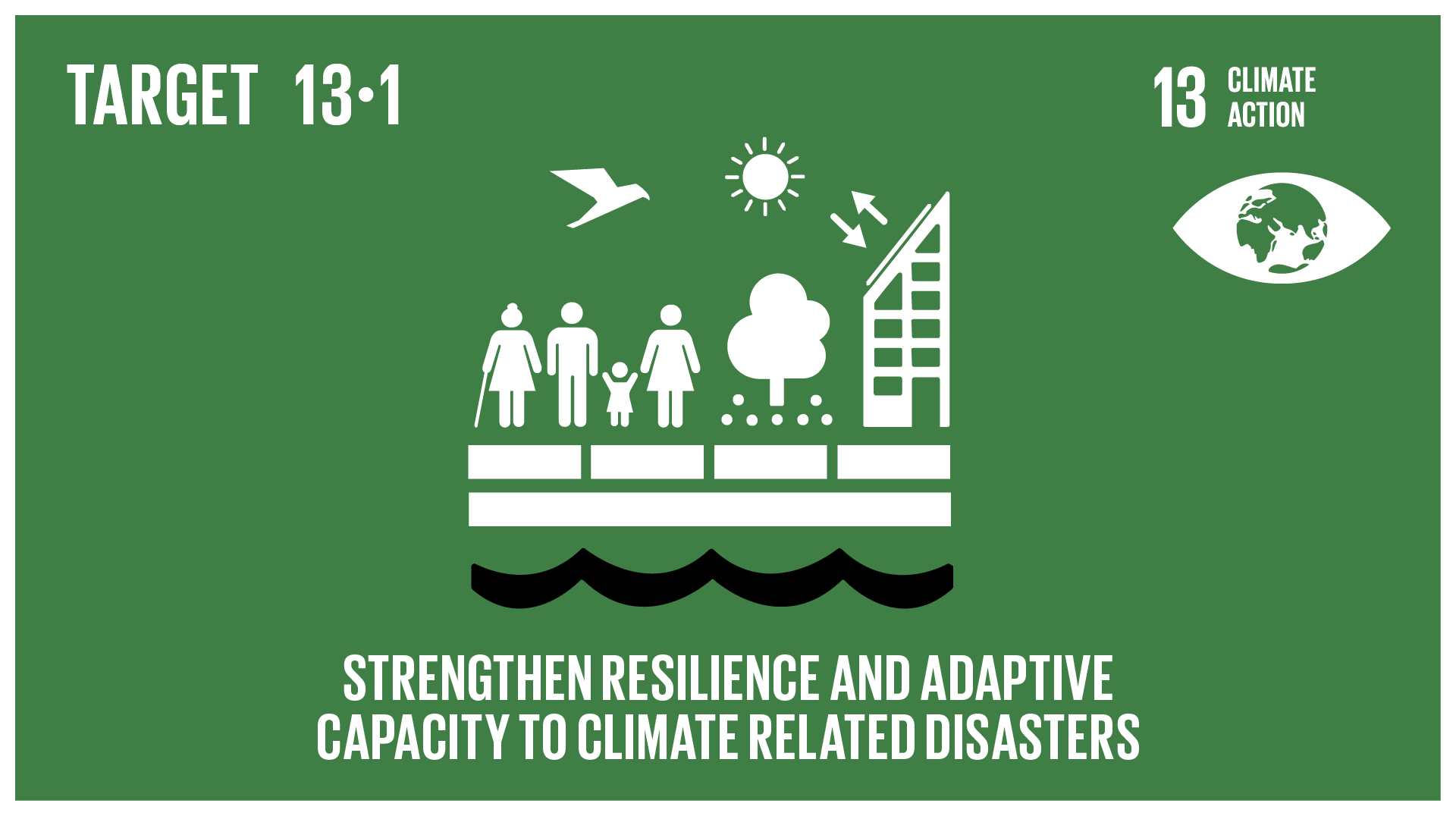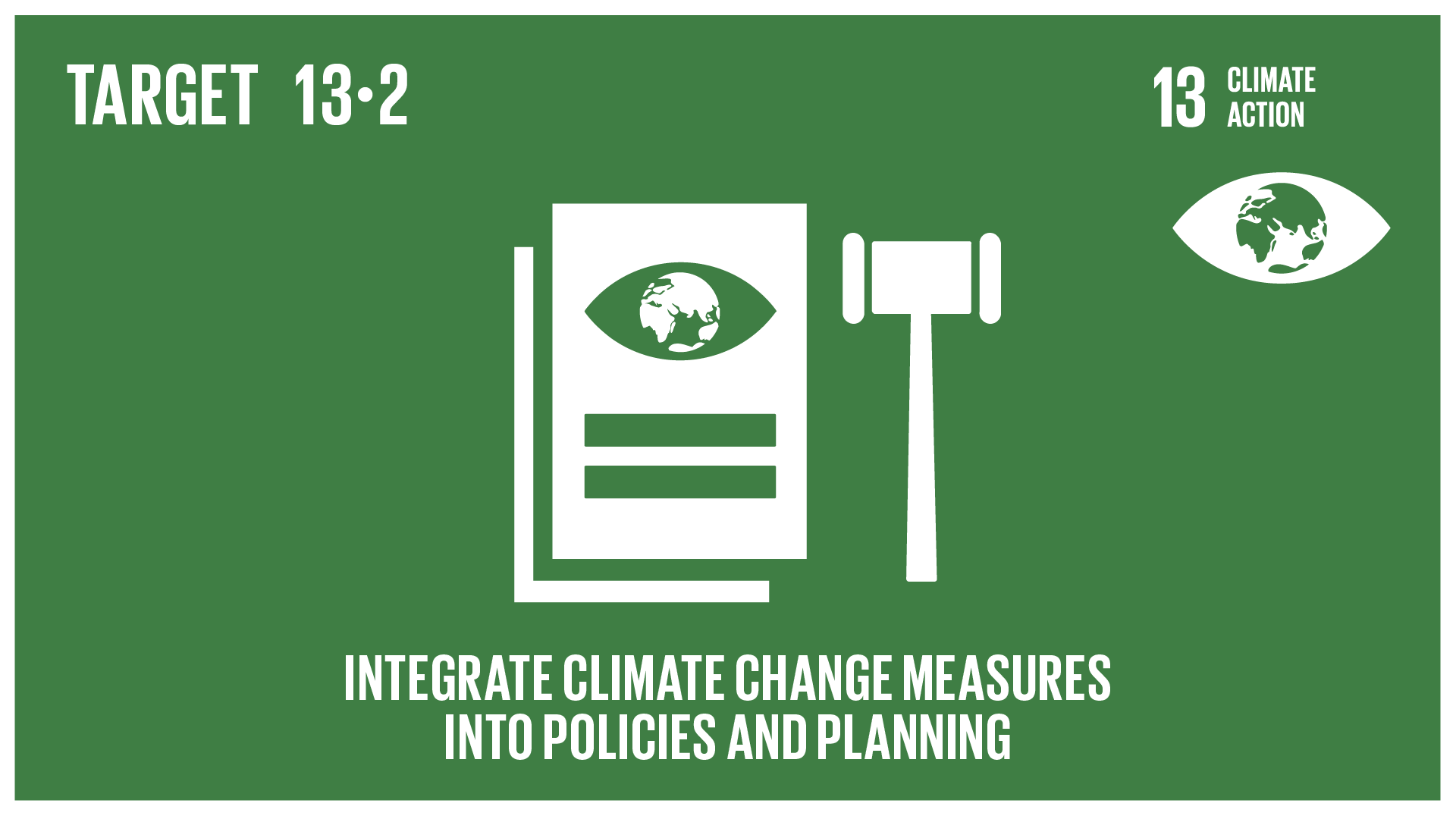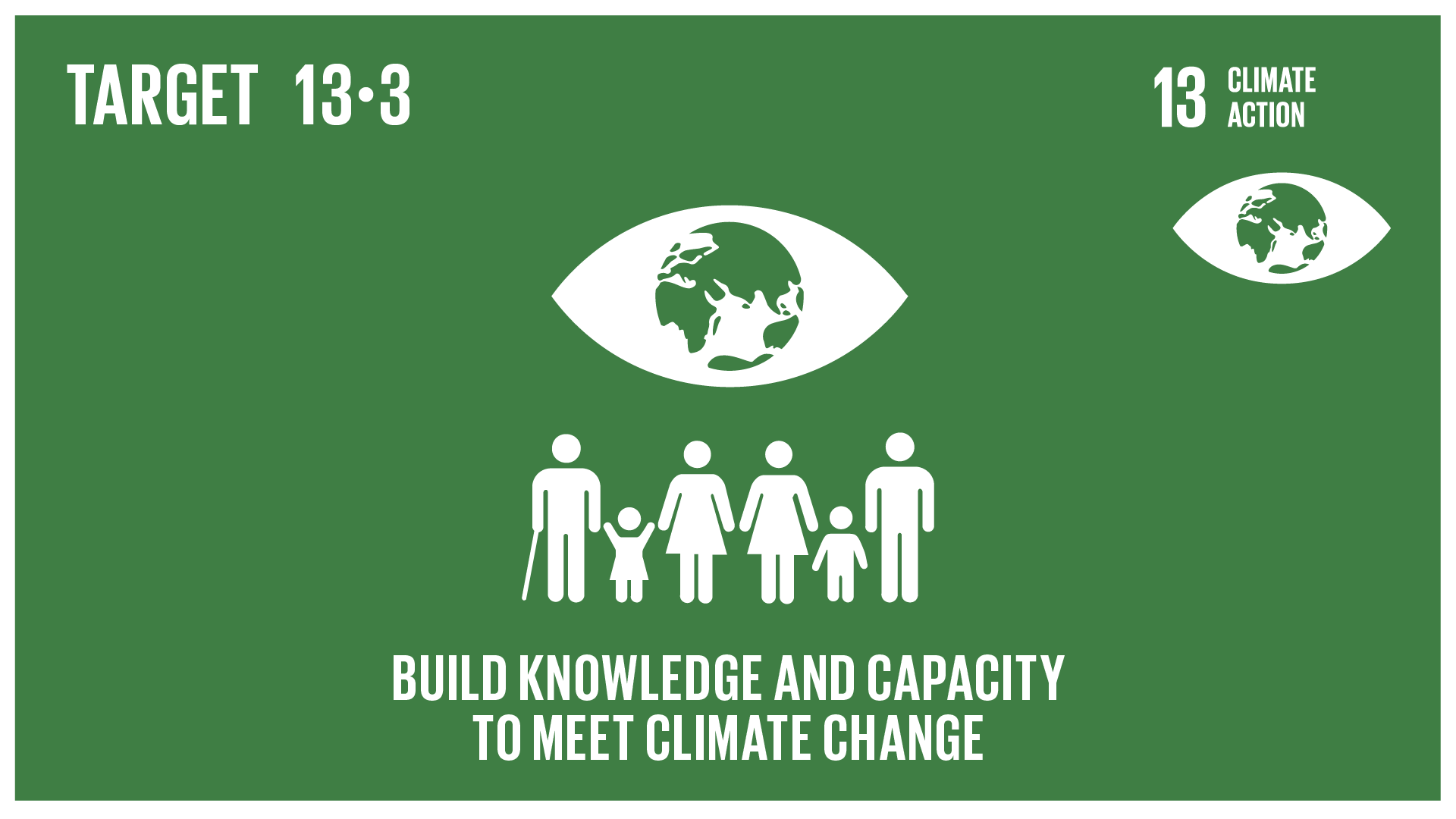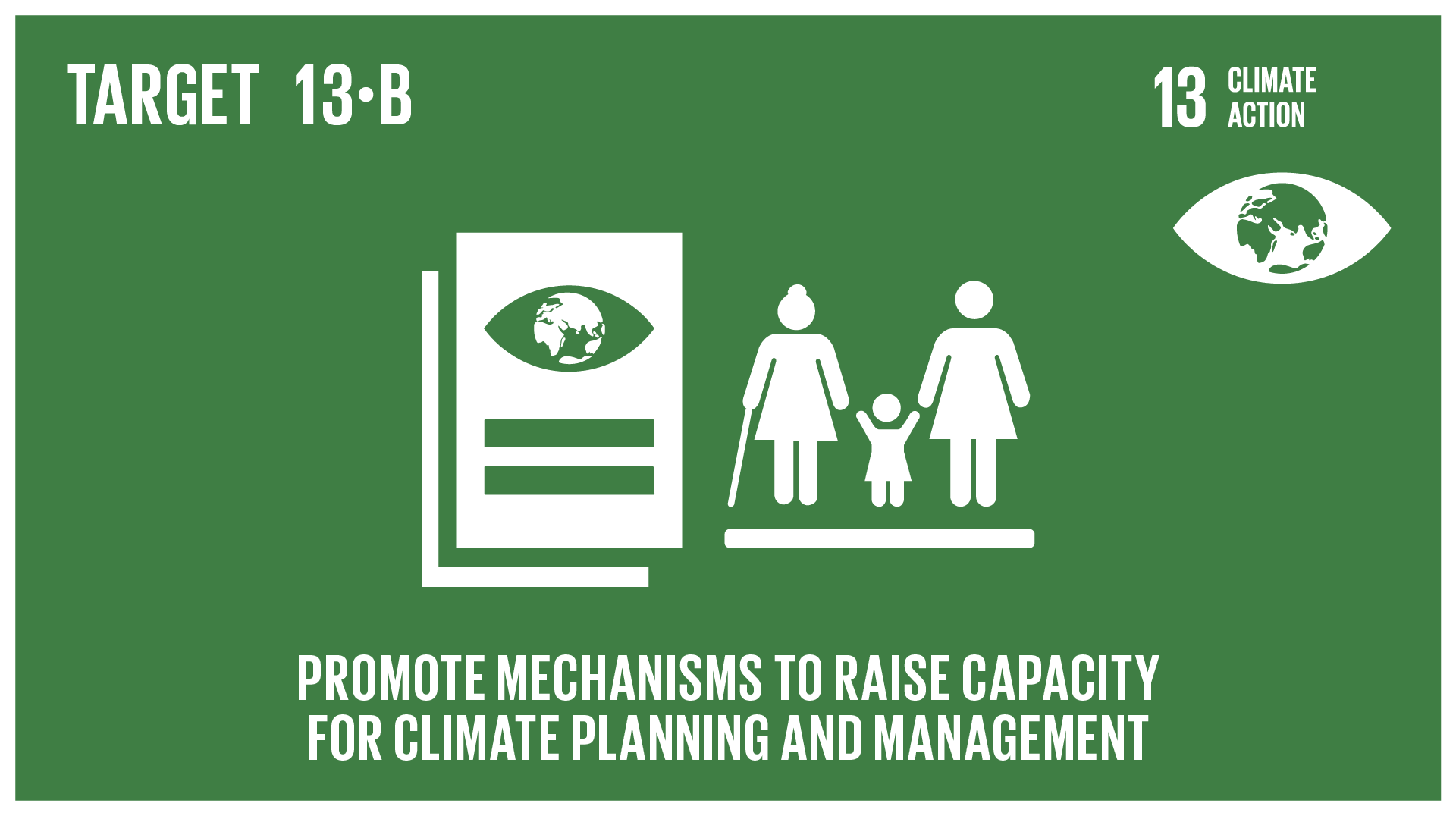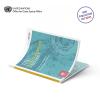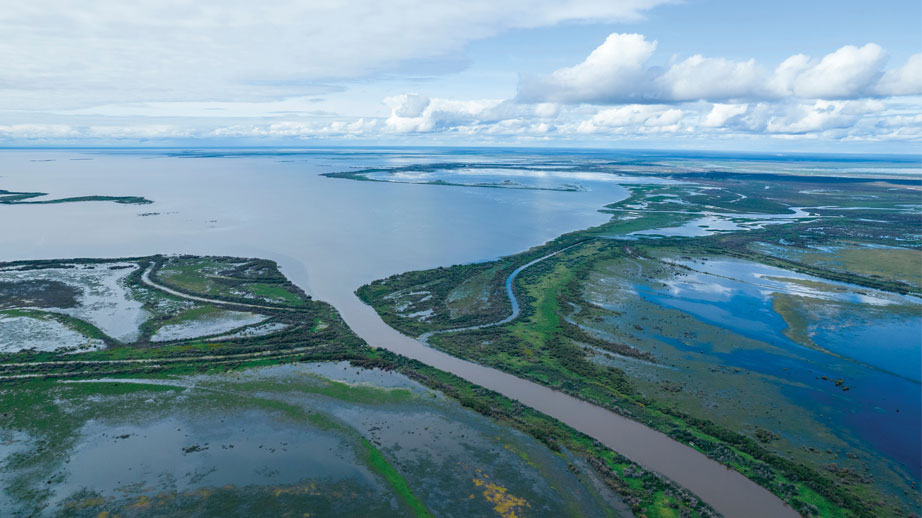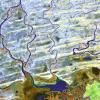SDG 13 - Climate action

Take urgent action to combat climate change and its impacts
Climate change is now affecting every country on every continent. It is disrupting national economies and affecting lives, costing people, communities and countries dearly today and even more tomorrow. Weather patterns are changing, sea levels are rising, weather events are becoming more extreme and greenhouse gas emissions are now at their highest levels in history. Without action, the world’s average surface temperature is likely to surpass 3 degrees centigrade this century. The poorest and most vulnerable people are being affected the most.
Affordable, scalable solutions are now available to enable countries to leapfrog to cleaner, more resilient economies. The pace of change is quickening as more people are turning to renewable energy and a range of other measures that will reduce emissions and increase adaptation efforts. Climate change, however, is a global challenge that does not respect national borders. It is an issue that requires solutions that need to be coordinated at the international level to help developing countries move toward a low-carbon economy.
To strengthen the global response to the threat of climate change, countries adopted the Paris Agreement at the COP21 in Paris, which went into force in November of 2016. In the agreement, all countries agreed to work to limit global temperature rise to well below 2 degrees centigrade. As of April 2018, 175 parties had ratified the Paris Agreement and 10 developing countries had submitted their first iteration of their national adaptation plans for responding to climate change.
Climate Summit 2019
The Secretary-General will convene a Climate Summit in September 2019 to bring climate action to the top of the international agenda. Mr. Luis Alfonso de Alba, a former Mexican diplomat, will be his Special Envoy to lead its preparations.
The Summit will focus on the heart of the problem – the sectors that create the most emissions and the areas where building resilience could make the biggest difference – as well as provide leaders and partners the opportunity to demonstrate real climate action and showcase their ambition.
To read about the commitments that regions, cities, businesses, investors and civil society pledged during the Global Climate Action Summit in California, September 2018, click here.
Facts and Figures
- As of April 2018, 175 parties had ratified the Paris Agreement and 168 parties had communicated their first nationally determined contributions to the UN framework convention on Climate Change Secretariat.
- As of April 2018, 10 developing countries had successfully completed and submitted their first iteration of their national adaptation plans for responding to climate change.
- Developed country parties continue to make progress towards the goal of jointly mobilizing $100 billion annually by 2020 for mitigation actions.
Thanks to the Intergovernmental Panel on Climate Change we know:
- From 1880 to 2012, average global temperature increased by 0.85°C. To put this into perspective, for each 1 degree of temperature increase, grain yields decline by about 5 per cent. Maize, wheat and other major crops have experienced significant yield reductions at the global level of 40 megatons per year between 1981 and 2002 due to a warmer climate.
- Oceans have warmed, the amounts of snow and ice have diminished and sea level has risen.From 1901 to 2010, the global average sea level rose by 19 cm as oceans expanded due to warming and ice melted. The Arctic’s sea ice extent has shrunk in every successive decade since 1979, with 1.07 million km² of ice loss every decade
- Given current concentrations and on-going emissions of greenhouse gases, it is likely that by the end of this century, the increase in global temperature will exceed 1.5°C compared to 1850 to 1900 for all but one scenario. The world’s oceans will warm and ice melt will continue. Average sea level rise is predicted as 24 – 30cm by 2065 and 40-63cm by 2100. Most aspects of climate change will persist for many centuries even if emissions are stopped
- Global emissions of carbon dioxide (CO2) have increased by almost 50 per cent since 1990
- Emissions grew more quickly between 2000 and 2010 than in each of the three previous decades
- It is still possible, using a wide array of technological measures and changes in behavior, to limit the increase in global mean temperature to two degrees Celsius above pre-industrial levels
- Major institutional and technological change will give a better than even chance that global warming will not exceed this threshold
* Acknowledging that the United Nations Framework Convention on Climate Change is the primary international, intergovernmental forum for negotiating the global response to climate change.
Space-based Technologies for SDG 13
Climate-related hazards can damage societies and economies worldwide. Satellites help monitor climate variables such as greenhouse gases, sea-level and deforestation. UNOOSA strengthens resilience to climate-related hazards and natural disasters, including by increasing access to space-based information for all countries through UN-SPIDER. Read more here.
Related Content
Article
卫星遥感技术在气溶胶监测以及水文循环研究的应用
Translated by Dr. Mengyi Jin
短时强降雨或长期干旱等极端天气事件往往会对地区经济、生态系统以及城市社区的正常运行造成负面影响。这些极端天气事件和大气中气溶胶的存在密切相关。气溶胶是悬浮于空气中的微小颗粒,它能够改变云的性质和降水过程,从而影响整个水文循环。因此,深入理解气溶胶、云以及水文循环之间的相互作用,对于应对气候变化具有重要意义。
近年来,随着太空技术的不断发展,尤其是卫星遥感技术的突破,气溶胶研究取得了重大进展。例如激光雷达(LiDAR)和多角度成像光谱辐射计等卫星遥感技术的广泛应用,使科学家们能够获取大气中气溶胶分布及其动态变化的高精度监测数据。这些数据有助于科学家们深入探讨气溶胶、降水以及水资源分布之间的关联(Winker et al. 2009)。通过大量实时监测数据,卫星遥感技术不仅提升了对水文循环的预测能力,也为提出应对水资源危机的政策建议提供了有力支持。
Les Femmes, l'Eau et l'Espace : Le Premier Rallye Géospatial Dédié aux Femmes et aux Aqueducs Ruraux
Un secreto oculto que se convierte en agua: el seguimiento del receso de los glaciares patagónicos
Translated by: Isabel Zetina
No hace mucho, en 1916, el explorador Padre De Agostini inspeccionó parte de la topografía de los glaciares Escondidos de la Patagonia (De Agostini, 1949). Hoy en día, la tecnología espacial, como las misiones ICESat de la NASA y los datos de la Shuttle Radar Topography Mission (SRTM), permiten seguir los cambios de los glaciares a lo largo del tiempo.
遥感技术在水敏感城市设计中的应用
Translated by Dr. Mengyi Jin
引言
随着城市化的快速推进,城市水环境正面临前所未有的挑战 (Chen et al. 2015)。城市地表不透水面的持续扩张削弱了自然雨水循环,导致降雨径流迅速汇集,增加了内涝发生的频率,也降低了雨水对地下水的补给能力。同时,水体污染以及城市热岛效应的加剧,进一步暴露出传统城市规划对水文系统适应性的不足。在气候变化背景下,极端降雨、干旱等事件的发生频率和强度不断上升,这些现象正严峻考验着城市对水资源的调蓄、排涝、净化和生态恢复等能力。
在这个背景下,水敏感城市设计(Water Sensitive Urban Design, WSUD)作为一种新型城市发展模式被广泛关注。与“低影响开发”(Low Impact Development, LID)理念相似, 水敏感城市设计强调模拟自然水循环过程,并提升城市应对水资源相关挑战的韧性。其核心目标在于将水资源视为城市系统中不可或缺的组成部分,通过系统性地管理水的收集、输送、处理与储存过程,实现其生态功能与社会功能的有机融合(Wong 2006)。
基于天基雷达的热带气旋监测和预报
Translated by Dr. Mengyi Jin
夏季来临时,热带气旋常在沿海地区引发洪涝灾害。早在古代,中国沿海的渔民就通过观察天气现象来预测热带气旋的来临,例如云层的形状和晚霞的变化。热带气旋发生在全球各地,不同地区对它的称呼也有所不同。在北大西洋、中北太平洋和东北太平洋地区,人们通常称之为“飓风”;而在西北太平洋地区,热带气旋常被称为“台风”。
近年来,热带气旋对美国、中国以及其他亚洲国家造成了重大损失。因此,发展基于太空的热带气旋监测技术,预测其路径并进行预警,对于保障民众的生命安全、保护渔业生产以及海上作业等具有重要意义。
双频降水雷达(Dual-frequency Precipitation Radar,简称 DPR)是由美国国家航空航天局(NASA)与日本宇宙航空研究开发机构(JAXA)联合开发的天基雷达系统,其搭载于热带降雨测量任务(TRMM)和全球降水观测计划(GPM)的卫星上(https://gpm.nasa.gov/missions/GPM/DPR),用于热带气旋的监测与科学研究(NASA,2018)。
A hidden secret that becomes water: Monitoring Patagonian Glacier Retreat
It was not long ago, in 1916, that the explorer Padre De Agostini surveyed part of the topography of the Escondidos glaciers (“hidden glaciers”, in English) in Patagonia (De Agostini, 1949). Today, space technology such as NASA’s ICESat Missions and Shuttle Radar Topography Mission (SRTM) data, allow to monitor changes in glaciers over time.
Наводнения в Судане - Космический мониторинг наводнений для управления рисками стихийных бедствий
Translated by Marina Agarkova
В 2019 году наводнения стали причиной 43,5% всех смертей в результате стихийных бедствий и, таким образом, представляют собой самый смертоносный тип бедствия с растущим числом событий по сравнению с предыдущими годами (CRED, 2019). Кроме того, наводнения приводят к наибольшему числу пострадавших людей по сравнению с другими бедствиями, поскольку они влияют на деятельность человека и экономику (CRED, 2019; Elagib et al. 2019).
Wetlands conservation: How satellite observation supports sustainable wetland management
On 2 February 2020, we celebrate World Wetlands Day to raise global awareness about the vital role of wetlands for people and our planet. This year’s edition highlights the connection between water, wetlands, and life.
基于卫星遥感的河流三角洲监测
Translated by Dr. Mengyi Jin
自古以来,河流三角洲因水资源丰富、土壤肥沃及交通便利而成为人类聚居的重要区域。这一格局延续至今。目前,生活在三角洲地区的人口已接近 60 亿,使其成为全球人口最稠密的地区之一(Kuenzer and Renaud 2011)。然而,这些三角洲地区正面临着气候变化、海平面上升、土地利用方式转变以及生态系统退化等威胁。遥感技术在获取环境状况及其时序变化方面具有显著优势,其在识别灾害前兆信号、预测自然现象演变等方面发挥着关键作用。在三角洲地区,遥感已被广泛应用于海岸线变化监测、洪水监测与预测等领域(Merkuryeva et al. 2015;Li and Damen 2010)。持续开展三角洲监测不仅有助于维护其生态功能,还能及时识别潜在风险,并为科学管理提供重要依据,而遥感正是实现这一目标的关键技术。
Un secreto oculto que se convierte en agua: el seguimiento del receso de los glaciares patagónicos
Translated by: Isabel Zetina
No hace mucho, en 1916, el explorador Padre De Agostini inspeccionó parte de la topografía de los glaciares Escondidos de la Patagonia (De Agostini, 1949). Hoy en día, la tecnología espacial, como las misiones ICESat de la NASA y los datos de la Shuttle Radar Topography Mission (SRTM), permiten seguir los cambios de los glaciares a lo largo del tiempo.
A hidden secret that becomes water: Monitoring Patagonian Glacier Retreat
It was not long ago, in 1916, that the explorer Padre De Agostini surveyed part of the topography of the Escondidos glaciers (“hidden glaciers”, in English) in Patagonia (De Agostini, 1949). Today, space technology such as NASA’s ICESat Missions and Shuttle Radar Topography Mission (SRTM) data, allow to monitor changes in glaciers over time.
Наводнения в Судане - Космический мониторинг наводнений для управления рисками стихийных бедствий
Translated by Marina Agarkova
В 2019 году наводнения стали причиной 43,5% всех смертей в результате стихийных бедствий и, таким образом, представляют собой самый смертоносный тип бедствия с растущим числом событий по сравнению с предыдущими годами (CRED, 2019). Кроме того, наводнения приводят к наибольшему числу пострадавших людей по сравнению с другими бедствиями, поскольку они влияют на деятельность человека и экономику (CRED, 2019; Elagib et al. 2019).
Wetlands conservation: How satellite observation supports sustainable wetland management
On 2 February 2020, we celebrate World Wetlands Day to raise global awareness about the vital role of wetlands for people and our planet. This year’s edition highlights the connection between water, wetlands, and life.
Space-based technology for aerosol monitoring and its role in the hydrological cycle
Extreme weather events, such as sudden downpours or prolonged droughts, disrupt economies, ecosystems, and communities. These events are closely linked to aerosols—tiny atmospheric particles that influence the hydrological cycle by altering cloud properties and precipitation. Understanding the interactions between aerosols, clouds, and the hydrological cycle is essential for managing climate variability.
Les Femmes, l'Eau et l'Espace : Le Premier Rallye Géospatial Dédié aux Femmes et aux Aqueducs Ruraux
A hidden secret that becomes water: Monitoring Patagonian Glacier Retreat
It was not long ago, in 1916, that the explorer Padre De Agostini surveyed part of the topography of the Escondidos glaciers (“hidden glaciers”, in English) in Patagonia (De Agostini, 1949). Today, space technology such as NASA’s ICESat Missions and Shuttle Radar Topography Mission (SRTM) data, allow to monitor changes in glaciers over time.
Наводнения в Судане - Космический мониторинг наводнений для управления рисками стихийных бедствий
Translated by Marina Agarkova
В 2019 году наводнения стали причиной 43,5% всех смертей в результате стихийных бедствий и, таким образом, представляют собой самый смертоносный тип бедствия с растущим числом событий по сравнению с предыдущими годами (CRED, 2019). Кроме того, наводнения приводят к наибольшему числу пострадавших людей по сравнению с другими бедствиями, поскольку они влияют на деятельность человека и экономику (CRED, 2019; Elagib et al. 2019).
Conservación de humedales: cómo la observación por satélite apoya la gestión sostenible de los humedales
Translated by: Isabel Zetina
El 2 de febrero de 2020 celebramos el Día Mundial de los Humedales para concienciar al mundo sobre el papel vital de los humedales para las personas y nuestro planeta. La edición de este año destaca la conexión entre el agua, los humedales y la vida.
Les Femmes, l'Eau et l'Espace : Le Premier Rallye Géospatial Dédié aux Femmes et aux Aqueducs Ruraux
基于数字孪生的现实条件海平面上升模拟
Translated by Dr. Mengyi Jin
数字孪生技术正越来越多地应用于模拟海平面上升所带来的影响,为城市规划、海岸管理和灾害应对等领域的决策者提供了宝贵的工具。这些虚拟模型整合了包括地理空间影像、人工智能和环境监测系统等不同来源的实时数据,可以详细模拟海平面上升对特定区域产生的影响。
通过准确绘制当前的土地覆盖特征,并不断用新数据更新这些模型,数字孪生使研究人员和政府部门能够在不同的气候变化条件下对未来的情景进行预测。这有助于识别脆弱区域、规划基础防护设施以及优化疏散策略。例如,高分辨率地理空间数据可以显示哪些区域面临洪水风险,而由人工智能驱动的模拟则可以预测海平面上升可能对当地生态系统和城市环境产生的长期影响。
通过将海平面上升纳入数字孪生模拟,城市规划者和环境科学家可以充分了解其对沿海地区的长期影响,从而为气候变化带来的挑战做好更加充分的准备。这项技术对于直观呈现和科学规划适应性应对措施,从而减缓海平面上升可能造成的损害具有重要意义。
Un secreto oculto que se convierte en agua: el seguimiento del receso de los glaciares patagónicos
Translated by: Isabel Zetina
No hace mucho, en 1916, el explorador Padre De Agostini inspeccionó parte de la topografía de los glaciares Escondidos de la Patagonia (De Agostini, 1949). Hoy en día, la tecnología espacial, como las misiones ICESat de la NASA y los datos de la Shuttle Radar Topography Mission (SRTM), permiten seguir los cambios de los glaciares a lo largo del tiempo.
Conservación de humedales: cómo la observación por satélite apoya la gestión sostenible de los humedales
Translated by: Isabel Zetina
El 2 de febrero de 2020 celebramos el Día Mundial de los Humedales para concienciar al mundo sobre el papel vital de los humedales para las personas y nuestro planeta. La edición de este año destaca la conexión entre el agua, los humedales y la vida.
LIFE Calls for Proposals 2025: claim your share of €600 million and help create a sustainable future for Europe!
The EU LIFE Programme is launching the 2025 Call for Proposals, and once again we want to help you take your green ideas to the next level. As the #ForOurPlanet campaign gets under way, there’s never been a better time to turn your vision into action! If you’ve got an idea for conserving nature, protecting the environment, taking climate action or transitioning Europe to clean energy, your project could be in for a share of the €600 million just announced for 2025.
Register for the 1st Space4Water Stakeholder Meeting - End or registration: 30 September
Space4Water stakeholders, featured young professionals and professionals, join us in Vienna at the 1st Space4Water Stakeholder Meeting.
Dates and location
The workshop will take place on 27-28 October 2022 at the Vienna International Centre, with an opportunity to host it online, should COVID prevent travels in October.
Registration
To be considered for participation Space4Water stakeholders and featured professionals can register here.
Register for the 3rd Space4Water Stakeholder Meeting: Registration open
24-25 October 2023, at the Vienna International Centre
organised by the United Nations Office for Outer Space Affairs
co-organised with the Prince Sultan Bin Abdulaziz International Prize for Water (PSIPW)
This event is restricted to Space4Water stakeholders, featured professionals, young professionals and representatives of Indigenous communities featured on the portal.
Register for the 2nd Space4Water Stakeholder Meeting - End of registration: 30 April
organised by UNOOSA in partnership with the Prince Sultan Bin Abdulaziz International Prize for Water (PSIPW)
11-12 May 2023, Online
This event is restricted to Space4Water stakeholders, featured professionals, young professionals and representatives of Indigenous communities featured on the portal.
Registration for speakers submitting technical presentations closes on 15 April 2023.
Registration for all other participants closes on 30 April 2023.
Capacity Building and Training Material
Event
The 32nd IAF workshop on "Resilient coasts, resilient Earth: Innovative space solutions for coastal resilience and emergency management"

With the support of the United Nations Office for Outer Space Affairs, the workshop takes place in Sydney, Australia 26 to 28 September 2025, in conjunction with the 76th International Astronautical Congress (IAC 2025) at the International Convention Centre, Sydney.
The 102nd AMS Annual Meeting
The American Meteorological Society Annual Meeting is the world’s largest yearly gathering for the weather, water, and climate community. It brings together great minds from a diverse set of scientific disciplines – helping attendees make career-long professional contact and life-long friends while learning from the very top people in the atmospheric sciences.
UNFCC COP 27

The Sharm el-Sheik Climate Change conference from 6-18 November 2022. More information about the conference and its preparations will be provided soon.
New! COP 27 Information for participants section launched. On this page you will find important information to help you plan your attendance at the COP in Sharm el-Sheik.
Host country information
Visit the COP27 Host country website
Delegation office space booking platform
United Nations/Costa Rica/PSIPW - Sixth conference on the use of space technology for water management
San José, Costa Rica, 7-10 May 2024 (with a possibility of online attendance) - streaming in UTC-8 time zone.
Hosted and supported by the Inter-American Institute for Cooperation on Agriculture (IICA)
Co-sponsored by the Prince Sultan Bin Abdulaziz International Prize for Water (PSIPW)
Participatory workshop for indigenous women on their roles and responsibilities related to water
register here until 21 August 2022 - if you would like to be considered for funding
In many places around the world women are responsible for water collection, a responsibility that globally takes them 200 million hours annually. It often leaves them with little to no time for school, work or to spend time with their family. Furthermore, indigenous communities' cultural heritage and knowledge about natural resources, including water, urgently needs to be considered and protected.
Local Perspectives Case Studies
Data-driven irrigation demand forecasting for rotational water management under the Warabandi system
Project / Mission / Initiative / Community Portal
WMO Hydrological Observing System Portal
Currently, WHOS makes available three data portals allowing users to easily leverage common WHOS functionalities such as data discovery and data access, on the web by means of common web browsers. For more information on WHOS data and available tools, please refer to the Section WHOS web services and supported tools.
WHOS-Global Portal provides all hydrometeorological data shared through WHOS. WHOS-Global Portal is implemented using the Water Data Explorer application.



